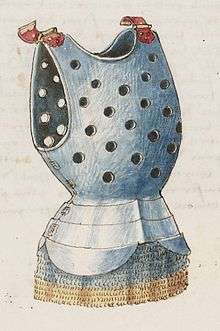Coif

A coif /ˈkɔɪf/ is a close fitting cap worn by both men and women[1] that covers the top, back, and sides of the head.
History
Coifs date from the 10th century, but fell out of popularity with men in the 14th century.[2] Coifs were worn by all classes in England and Scotland from the Middle Ages to the early seventeenth century (and later as an old-fashioned cap for countrywomen and young children).
Tudor (later Stewart in Scotland) and earlier coifs are usually made of unadorned white linen and tied under the chin. In the Elizabethan and early Jacobean eras, coifs were frequently decorated with blackwork embroidery and lace edging. Coifs were worn under gable hoods and hats of all sorts, and alone as indoor headcoverings.
Coifs were also worn by a now-defunct senior grade of English lawyer, the Serjeant-at-Law even after they became judges.[2] A United States law school honor society, the Order of the Coif, is named after this use of the coif.
The traditional religious habit of Catholic nuns and Religious Sisters included a coif as a headpiece, along with the white cotton cap secured by a bandeau, to which the veil would be attached, along with a white wimple or guimpe of starched linen or cotton to cover the cheeks, neck and chest.
A mail coif was a type of armour, made of mail, which covered the head (face excluded), neck and shoulders.
See also
.jpg)
References
- ↑ Yarwood, Doreen (2011) [1978]. Illustrated History of World Costume. Mineola, New York: Dover Publications, Inc. p. 104. ISBN 978-0-486-43380-6.
- 1 2 "A New Look for Women." Arts and Humanities Through the Eras. Gale. 2005. Retrieved August 13, 2012 from HighBeam Research: http://www.highbeam.com/doc/1G2-3427400451.html
- Oxford English Dictionary
- Digby, George Wingfield (1964) Elizabethan Embroidery. New York: Thomas Yoseloff

